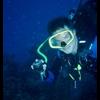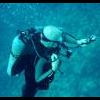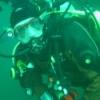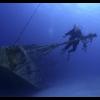SAC is how many psi per minute (I have seen it expressed as 'cubic feet' or 'pounds' as well in some references) you consume from your tank when just below the surface
Some people have it that SAC is always rate of pressure change (measured in psi or bar per minute), whilst RMV (respiratory minute volume) is rate of consumption (measured in cu.ft. or litres per minute). But usage has changed this, and the most useful definition of SAC now is that it is rate of consumption. It's not measured just below the surface but at some more substantial depth, with the result then extrapolated to the surface. Knowing that extrapolated surface figure you can then calculate nominal consumption at any depth.
Rate of pressure change clearly has no general application unless you know the volume of the tank it's been measured on, and this is where Americans have already shot themselves in the foot! Under the European system the actual volume of a tank is given in litres or cubic feet, so its capacity (the amount of gas at surface conditions compressed into it) is that volume multiplied by whatever pressure happens to be in the tank, in bar. So converting between volume and pressure is very easy, and SAC calculations are trivial.
Under the American system you don't know the volume of the tank. You're told how much gas can be compressed into it, but unless you know at what exact pressure that's measured you don't have a starting point for SAC calculations. This is the problem - you need to examine the tank markings to find the nominal rated pressure of the tank, on the assumption that that is the pressure at which its capacity was measured. If over-pressurisation is permitted (usually denoted by a + sign after the pressure number) then you need to understand whether it's the marked pressure you should use, or that pressure uplifted by the permitted over-pressurisation (usually 10%). Sadly, although there are norms there are also deviations from the norm, and just looking at the markings on a tank will not allow you to state definitively what the volume is. If you don't believe me try asking the tank manufacturers.
To me the US system is crazy, as it takes what is intrinsically simple and certain and makes it complicated and uncertain. I have lots of different sized tanks from lots of manufacturers, aluminum and steel, and the relationship between stated capacity and actual volume varies between them. Rather similar to the way lead acid auto batteries are marked. In Europe the following information appears on the battery label - number of cells, nominal voltage, maximum or starting current (measured in amps), and capacity (measured in ampere hours). In America so far as I can tell the last item, the capacity of the battery, never appears. When I want to fit a battery to a boat I clearly need to know two key things - whether it can deliver the required starting current, and how long I can leave running lights and auxilary equipment on and know that I'll be able to start the engine. I've bought lots of marine batteries in the USA from lots of manufacturers, and not one has given me that second vital piece of information. In Britain it's the first item given after the voltage, always.
Back to SAC. Once you know your gas consumption rate you can calculate how fast your tank pressure will drop at different point of a dive, crucial to gas planning. I also initially learned this at the Adv EANx level (in Florida), though as I began to understand the American tank measurement system I realised my instructor hadn't understood it himself and had actually mis-calculated tank volumes - he was wrong in what he thought was the pressure used by the manufacturer to calculate the capacity of the tank.
This of course won't be a problem for someone who buys their own tanks. Just make sure what the actual volume of each tank is and all subsequent SAC calculations are relatively easy.






















